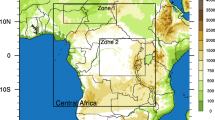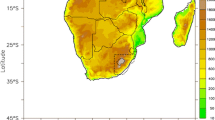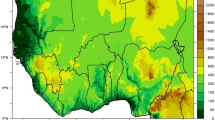Abstract
The assessment of ENSO influence on extreme rainfall events over South America will provide useful information to climate services. This research analyzes the performance of eleven global climate models (GCMs) from the Coupled Model Intercomparison Project Phase 5 (CMIP5) using skill score metrics to simulate two climate extreme rainfall indices: maximum number of consecutive dry days (CDD) and wet days (CWD). Additionally, another objective of this study is to characterize the spatial relationship between different types of El Niño–Southern Oscillation (ENSO)–El Niño Modoki Index (EMI) and Oceanic Niño Index (ONI)– and those indices of climate extremes of rainfall. The development of this research is carried out in South America, in the trimester October–December from “historical” experiment for the period 1979–2005. In general terms, the mean fields of CDD and CWD indices tend to be opposite, with main differences in Amazonas, Atacama Desert, and northeast of Brazil. The CDD–EMI and CDD–ONI correlations show a greater signal than CWD in South America. The CDD–EMI correlation is negative; nevertheless, the CDD-El Niño Modoki composite shows positive values in the northeast of Buenos Aires province. It can be concluded that most models are able to reproduce the gridded observed spatial pattern of extreme rainfall indices and their association with ENSO events. The results of this investigation could be a tool for new studies to analyze and compare the “historical” period with future projections in a context of climate change.















Similar content being viewed by others
References
Accadia C, Mariani S, Casaioli M, Lavagnini A, Speranza A (2003) Sensitivity of precipitation forecast skill scores to bilinear interpolation and a simple nearest-neighbor average method on high-resolution verification grids. Weather Forecast 18(5):918–932
Aceituno P, Montecinos A (1992) Análisis de la estabilidad de la relación entre la Oscilación del Sur y la precipitación en América del Sur. In Paleo ENSO Records. International Symposium (eds Ortlieb L, Macharé J): 7-13
Alexander L, Zhang X, Peterson T, Caesar J, Gleason B, Tank A, Haylock M, Collins D, Trewin B, Rahimzadeh F, Tagipour A, Rupa Jumar K, Revadekar J, Griffiths G, Vincent L, Stephenson D, Burn J, Aguilar E, Brunet M, Taylor M, New M, Zhai P, Rusticucci M, Varzquez-Aguirre J (2006) Global observed changes in daily climate extremes of temperature and precipitation. J Geophys Res Atmos 111(D5)
Andreoli R, de Oliveira S, Kayano M, Viegas J, de Souza R, Candido L (2016) The influence of different el Niño types on the south American rainfall. Int J Climatol 37(3):1374–1390
Aravena C, Luckman H (2009) Spatio-temporal rainfall patterns in southern South America. Int J Climatol J R Meteorol Soc 29(14):2106–2120
Ashok K, Behera S, Rao S, Weng H, Yamagata T (2007) El Niño Modoki and its possible teleconnection. J Geophys Res 112:C11007
Ashok K, Tam CY, Lee WJ (2009) ENSO Modoki impact on the Southern Hemisphere storm track activity during extended austral winter. Geophys Res Lett 36(12)
Barros V, Doyle M, Camilloni I (2008) Precipitation trends in southeastern South America: relationship with ENSO phases and with low-level circulation. Theor Appl Climatol 93(1–2):19–33
Bettolli M, Penalba O, Vargas W (2005) Características de la precipitación diaria en la región núcleo sojera argentina. IX Congreso Argentino de Meteorología, Argentina
Blázquez J, Nuñez M (2013) Analysis of uncertainties in future climate projections for South America: comparison of WCRP-CMIP3 and WCRP-CMIP5 models. Clim Dyn 41(3–4):1039–1056
Boulanger J, Leloup J, Penalba O, Rusticucci M, Lafon F, Vargas W (2005) Observed precipitation in the Paraná-Plata hydrological basin: long-term trends, extreme conditions and ENSO teleconnections. Clim Dyn 24:393–413
Carbone M, Piccolo M, Scian B (2004) Análisis de los períodos secos y húmedos en la cuenca del Arroyo Claromecó, Argentina. Papeles Geografía 40:25–35
Cavalcanti I, Carril A, Penalba O et al (2015) Precipitation extremes over La Plata Basin–review and new results from observations and climate simulations. J Hydrol 523:211–230
Chen M, Shi W, Xie P, Silva VB, Kousky VE, Wayne Higgins R, Janowiak JE (2008) Assessing objective techniques for gauge-based analyses of global daily precipitation. J Geophys Res Atmos 113(D4)
Chen C, Cane M, Wittenberg A, Chen D (2017) ENSO in the CMIP5 simulations: life cycles, diversity, and responses to climate change. J Clim 30:775–801
Coelho C, Uvo C, Ambrizzi T (2002) Exploring the impacts of the tropical Pacific SST on the precipitation patterns over South America during ENSO periods. Theor Appl Climatol 71(3–4):185–197
Collier M, Uhe P (2012) CMIP5 datasets from the ACCESS1.0 and ACCESS1.3 coupled climate models. Centre for Australian weather and Climate Research
Collins W, Bellouin N, Doutriaux-Boucher M et al (2011) Development and evaluation of an Earth-system model–HadGEM2. Geosci Model Dev 4(4):1051–1075
Córdoba-Machado S, Palomino-Lemus R, Gámiz-Fortis S, Castro-Díez Y, Esteban-Parra M (2015) Assessing the impact of El Niño Modoki on seasonal precipitation in Colombia. Glob Planet Chang 124:41–61
Díaz L, Vera C (2017) Austral summer precipitation interannual variability and trends over southeastern South America in CMIP5 models. Int J Climatol 37(S1):681–695
Doblas-Reyes F, García-Serrano J, Lienert F, Pinto Biescas A, Rodrigues L (2013) Seasonal climate predictability and forecasting: status and prospects. WIREs Clim Change 2013(4):245–268. https://doi.org/10.1002/wcc.217
Donat M, Alexander L, Yang H, Durre I, Vose R, Caesar J (2013) Global land-based datasets for monitoring climatic extremes. Bull Amer Meteor Soc 94:997–1006
Dufresne J, Foujols M, Denvil S, Caubel A, Marti O, Aumont O, Bony S (2013) Climate change projections using the IPSL-CM5 Earth system model: from CMIP3 to CMIP5. Clim Dyn 40(9–10):2123–2165
Gent P, Danabasoglu G, Donner L et al (2011) The community climate system model version 4. J Clim 24(19):4973–4991
Gulizia C, Camilloni I (2015) Comparative analysis of the ability of a set of CMIP3 and CMIP5 global climate models to represent precipitation in South America. Int J Climatol 35(4):583–595
Haylock M, Peterson T, Alves L, Ambrizzi T, Anunciação T, Baez J, Barros V, Berlato M, Bidegain M, Coronel G, Corradi V, Garcia V, Grimm A, Karoly D, Marengo A, Marino M, Moncunill D, Nechet D, Quintana J, Rebello E, Rusticucci M, Santos J, Trebejo I, Vincent L (2006) Trends in total and extreme South American rainfall 1960–2000 and links with sea surface temperature. J Clim 19:1490–1512
Hazeleger W, Wang X, Severijns C, Ştefănescu S, Bintanja R, Sterl A, Wyser K, Semmler T, Yang S, van den Hurk B, van Noije T, van der Linden E, van der Wiel K (2012) EC-earth V2. 2: description and validation of a new seamless Earth system prediction model. Clim Dyn 39:2611–2629
Huang B, Thorne P, Banzon V, Boyer T, Chepurin G, Lawrimore J, Menne M, Smith T, Vose R, Zhang H (2017) Extended reconstructed sea surface temperature, version 5 (ERSSTv5): upgrades, validations, and intercomparisons. J Clim 30(20):8179–8205
Huang D, Yan P, Zhu J, Zhang Y, Kuang X, Cheng J (2018) Uncertainty of global summer precipitation in the CMIP5 models: a comparison between high-resolution and low-resolution models. Theor Appl Climatol 132(1–2):55–69
Jeffrey J, Rotstayn L, Collier A, Dravitzki S, Hamalainen C, Moeseneder C, Syktus J (2013) Australia’s CMIP5 submission using the CSIRO Mk3. 6 model. Aust Meteor Oceanogr J 63:1–13
Karlen D, Rice C (2015) Soil degradation: will humankind ever learn?
Knutti R, Furrer R, Tebaldi C, Cermak J, Meehl G (2010) Challenges in combining projections from multiple climate models. J Clim 23(10):2739–2758
Navarro-Monterroza E, Arias P, Vieira C (2019) El Niño/Southern Oscillation Modoki and its effects on the spatiotemporal variability of precipitation in Colombia. Rev Acad Colomb Cienc Exactas Físicas Naturales 43(166):120–132
New M, Hewitson B, Stephenson D, Tsiga A, Kruger A, Manhique A, Gomez B, Coelho CA, Masisi D, Kululanga E, Mbambalala E, Adesina F, Saleh H, Kanyanga J, Adosi J, Bulane L, Fortunata L, Mdoka M, Lajoie R (2006) Evidence of trends in daily climate extremes over southern and west Africa. J Geophys Res Atmos 111(D14)
Pearson K (1920) Notes on the history of correlation. Biometrika 13:25–45
Penalba O, Rivera J (2016) Precipitation response to El Niño/La Niña events in southern South America-emphasis in regional drought occurrences. Adv Geosc 42:1–14
Penalba O, Beltran A, Messina C (2005) Monthly rainfall in central-eastern Argentina and ENSO: a comparative study of rainfall forecast methodologies. Rev Bras Agromet 13(2):49–61
Penalba O, Pántano V, Spescha L, Murphy G (2019) El Niño-Southern Oscillation incidence over long dry sequences and their impact on soil water storage in Argentina. Int J Climatol 39:2362–2374. https://doi.org/10.1002/joc.5957
Raddatz TJ, Reick CH, Knorr W, Kattge J, Roeckner E, Schnur R, Schnitzler KG, Wetzel P, Jungclaus J (2007) Will the tropical land biosphere dominate the climate-carbon cycle feedback during the twenty-first century? Clim Dyn 29(6):565–574
Rao J, Rong-Cai R (2014) Statistical characteristics of ENSO events in CMIP5 models. Atmos Oceanic Sci Lett 7(6)
Ratnam V, Behera K, Masumoto Y, Takahashi K, Yamagata T (2012) Anomalous climatic conditions associated with the El Niño Modoki during boreal winter of 2009. Clim Dyn 39(1–2):227–238
Rivera J, Penalba O (2014) Trends and spatial patterns of drought affected area in southern South America. Climate 2:264–278. https://doi.org/10.3390/cli2040264
Ropelewski C, Halpert M (1987) Global and regional scale precipitation patterns associated with the El Niño/Southern Oscillation. Mon Weather Rev 115(8):1606–1626
Skansi M, Brunet M, Sigró J, Aguilar E, Groening J, Bentancur O, Rojas C (2013) Warming and wetting signals emerging from an analysis of changes in climate extreme indices over South America, Global Planet. Change 100:295–307
Takahashi K, Montecinos A, Goubanova K, Dewitte B (2011) ENSO regimes: reinterpreting the canonical and Modoki El Niño. Geophys Res Lett 38(10)
Taylor K, Stouffer R, Meehl G (2012) An overview of CMIP5 and the experiment design. Bull Amer Meteor Soc 93:485–498
Tedeschi R, Collins M (2016) The influence of ENSO on South American precipitation during austral summer and autumn in observations and models. Int J Climatol 36(2):618–635
Tedeschi R, Cavalcanti I, Grimm A (2013) Influences of two types of ENSO on South American precipitation. Int J Climatol 33:1382–1400
Trenberth K (1997) The definition of El Nino. Bull Am Meteorol Soc 78(12):2771–2778
Vincent L, Peterson T, Barros V et al (2005) Observed trends in indices of daily temperature extremes in South America 1960–2000. J Clim 18(23):5011–5023
Voldoire A, Sanchez-Gomez E, Salas y Mélia D et al (2013) The CNRM-CM5. 1 global climate model: description and basic evaluation. Clim Dyn 40(9–10):2091–2121
Volodin E, Dianskii N, Gusev A (2010) Simulating present-day climate with the INMCM4. 0 coupled model of the atmospheric and oceanic general circulations. Izv Atmos Ocean Phys 46(4):414–431
Watanabe M, Suzuki T, O’ishi R, Komuro Y, Watanabe S, Emori S, Takemura T, Chikira M, Ogura T, Sekiguchi M, Takata K, Yamazaki D, Yokohata T, Nozawa T, Hasumi H, Tatebe H, Kimoto M (2010) Improved climate simulation by MIROC5: mean states, variability, and climate sensitivity. J Clim 23(23):6312–6335
Weng H, Ashok K, Behera S, Rao A, Yamagata T (2007) Impacts of recent El Niño Modoki on dry/wet conditions in the Pacific rim during boreal summer. Clim Dyn 29(2–3):113–129
World Meteorological Organization (2014) Implementation plan of the global framework for climate services (GFCS). Geneva: Author
Xie P, Chen M, Shi W (2010) CPC unified gauge-based analysis of global daily precipitation. In Preprints, 24th Conference on Hydrology, Atlanta, GA. Amer Meteor Soc (2)
Yukimoto S, Adachi Y, Hosaka M et al (2012) A new global climate model of the Meteorological Research Institute: MRI-CGCM3—model description and basic performance. J Meteorol Soc Japan Ser II 90:23–64
Zhou J, Lau K (2001) Principal modes of interannual and decadal variability of summer rainfall over South America. Int J Climatol J R Meteorol Soc 21(13):1623–1644
Funding
This work has been supported by the projects UBA-20020170100357BA from the University of Buenos Aires and Consejo Nacional de Investigaciones Científicas y Técnicas (CONICET) PIP 0137.
Author information
Authors and Affiliations
Corresponding author
Additional information
Publisher’s note
Springer Nature remains neutral with regard to jurisdictional claims in published maps and institutional affiliations.
Rights and permissions
About this article
Cite this article
Iacovone, M.F., Pántano, V.C. & Penalba, O.C. Consecutive dry and wet days over South America and their association with ENSO events, in CMIP5 simulations. Theor Appl Climatol 142, 791–804 (2020). https://doi.org/10.1007/s00704-020-03324-y
Received:
Accepted:
Published:
Issue Date:
DOI: https://doi.org/10.1007/s00704-020-03324-y




